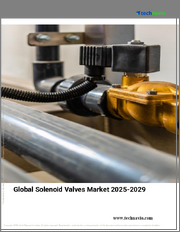
|
시장보고서
상품코드
1417438
세계의 솔레노이드 밸브 시장 : 동향, 예측 및 경쟁 분석Solenoid Valves Market Report: Trends, Forecast and Competitive Analysis |
||||||
솔레노이드 밸브 시장 동향 및 전망
세계 솔레노이드 밸브 시장 규모는 2024-2030년간 연평균 3.7% 성장하여 2030년까지 약 56억 달러에 달할 것으로 예상됩니다. 이 시장의 주요 촉진요인은 살균, 저온 살균 시스템, 농산물 가공, 식품 냉동에서 솔레노이드 밸브의 사용 확대, 공정 자동화 증가, 수처리 플랜트 수요 증가 등입니다. 세계 솔레노이드 밸브 시장의 미래는 석유 및 가스, 화학 및 석유화학, 식품 및 음료, 발전, 제약, 자동차, 의료 시장에서의 기회로 인해 유망해 보입니다.
솔레노이드 밸브 시장 인사이트
Lucintel은 직동식 밸브가 위험한 장소에서의 사용 증가로 인해 예측 기간 동안 직동식 밸브가 더 큰 부문으로 남을 것으로 예상하고 있습니다.
화학 및 석유화학은 가스, 액체, 증기 및 화합물 제어를 위해 이러한 밸브의 채택이 증가함에 따라 이 시장에서 가장 큰 부문으로 남을 것입니다.
아태지역은 깨끗한 물 유지에 대한 관심 증가와 수처리 플랜트에 대한 투자 증가로 인해 예측 기간 동안 가장 높은 성장세를 보일 것으로 예상됩니다.
자주 묻는 질문
Q.1 솔레노이드 밸브 시장 규모는?
A1. 세계 솔레노이드 밸브 시장은 2030년까지 약 56억 달러에 달할 것으로 예상됩니다.
Q2, 솔레노이드 밸브 시장의 성장 전망은?
A2. 세계 솔레노이드 밸브 시장은 2024-2030년까지 연평균 3.7%의 성장률을 보일 것으로 예상됩니다.
Q3. 솔레노이드 밸브 시장의 성장에 영향을 미치는 주요 촉진요인은 무엇인가?
A3.이 시장의 주요 촉진요인은 살균, 저온 살균 시스템, 농산물 가공 및 식품 냉동에서 솔레노이드 밸브의 사용 확대, 공정 자동화에 대한 성향 증가, 수처리 공장에 대한 수요 증가입니다.
Q4. 시장의 주요 부문은?
A4. 솔레노이드 밸브 시장의 미래는 석유 및 가스, 화학 및 석유화학, 식품 및 음료, 발전, 제약, 자동차, 의료 시장에서의 기회로 인해 유망해 보입니다.
Q5. 시장의 주요 기업은?
A5. 솔레노이드 밸브의 주요 기업 중 일부는 다음과 같습니다.
- Airtac
- ASCO Valve
- Danfoss Industries Limited
- Curtiss
- Wright Corporation
- IMI Precision Engineering
- Emerson Electric
- Juliang Valve
- Parker Hannifin Corporation
- Zhejiang Yongjiu
Q6. 향후 가장 큰 시장 부문은?
A6.Lucintel은 예측 기간 동안 직동식 밸브가 위험한 장소에서의 사용 증가로 인해 직동식 밸브가 더 큰 부문으로 남을 것으로 예상했습니다.
Q7. 향후 5년간 가장 큰 시장으로 성장할 것으로 예상되는 지역은?
A7. 아시아태평양은 깨끗한 물 유지에 대한 관심이 높아지고 수처리 플랜트에 대한 투자가 증가함에 따라 예측 기간 동안 가장 높은 성장세를 보일 것으로 예상됩니다.
Q8. 보고서 커스터마이징이 가능한가?
A8. 네. Lucintel은 추가 비용없이 10%의 사용자 정의를 제공합니다.
목차
제1장 주요 요약
제2장 세계의 솔레노이드 밸브 시장 : 시장 역학
- 서론, 배경, 분류
- 공급망
- 업계 촉진요인과 과제
제3장 시장 동향과 예측 분석 : 2018-2030년
- 거시경제 동향(2018-2023년)과 예측(2024-2030년)
- 세계의 솔레노이드 밸브 시장 동향(2018-2023년)과 예측(2024-2030년)
- 세계의 솔레노이드 밸브 시장 : 유형별
- Direct-Acting Valves
- Pilot-Operated Valves
- 세계의 솔레노이드 밸브 시장 : 소재별
- 스테인리스 스틸
- 알루미늄
- 플라스틱
- 기타
- 세계의 솔레노이드 밸브 시장 : 미디어별
- 공기
- 가스
- 물
- 세계의 솔레노이드 밸브 시장 : 최종 이용 산업별
- 석유 및 가스
- 화학제품 및 석유화학제품
- 식품 및 음료
- 발전
- 제약
- 자동차
- 의료
- 기타
제4장 시장 동향과 예측 분석 : 지역별(2018-2030년)
- 세계의 솔레노이드 밸브 시장 : 지역별
- 북미
- 유럽
- 아시아태평양
- 기타 지역
제5장 경쟁 분석
- 제품 포트폴리오 분석
- 운영상 통합
- Porter의 Five Forces 분석
제6장 성장 기회와 전략적 분석
- 성장 기회 분석
- 유형별
- 소재별
- 미디어별
- 최종 이용 산업별
- 지역별
- 세계 솔레노이드 밸브 시장의 새로운 동향
- 전략적 분석
- 신제품 개발
- 세계의 솔레노이드 밸브 시장 능력 확대
- 세계 솔레노이드 밸브 시장의 인수합병(M&A) 및 합작투자(JV)
- 인증 및 라이선싱
제7장 유력 기업 개요
- Airtac
- ASCO Valve
- Danfoss Industries Limited
- Curtiss
- Wright Corporation
- IMI Precision Engineering
- Emerson Electric
- Juliang Valve
- Parker Hannifin Corporation
- Zhejiang Yongjiu
Solenoid Valves Market Trends and Forecast
The future of the global solenoid valves market looks promising with opportunities in the oil & gas, chemical & petrochemical, F&B, power generation, pharmaceutical, automotive, and medical markets. The global solenoid valves market is expected to reach an estimated $5.6 billion by 2030 with a CAGR of 3.7% from 2024 to 2030. The major drivers for this market are expanding utilization of solenoid valves in sterilization, pasteurization systems, agro-food processing, and food freezing, rising inclination towards process automation, and growing demand water treatment plants.
A more than 150-page report is developed to help in your business decisions.
Solenoid Valves Market by Segment
The study includes a forecast for the global solenoid valves market by type, material, media, end use industry, and region
Solenoid Valves Market by Type [Shipment Analysis by Value from 2018 to 2030]:
- Direct-Acting Valves
- Pilot-Operated Valves
Solenoid Valves Market by Material [Shipment Analysis by Value from 2018 to 2030]:
- Stainless Steel
- Aluminum
- Plastic
- Others
Solenoid Valves Market by Media [Shipment Analysis by Value from 2018 to 2030]:
- Air
- Gas
- Water
Solenoid Valves Market by End Use Industry [Shipment Analysis by Value from 2018 to 2030]:
- Oil & Gas
- Chemical & Petrochemical
- F&B
- Power Generation
- Pharmaceuticals
- Automotive
- Medical
- Others
Solenoid Valves Market by Region [Shipment Analysis by Value from 2018 to 2030]:
- North America
- Europe
- Asia Pacific
- The Rest of the World
List of Solenoid Valves Companies
Companies in the market compete on the basis of product quality offered. Major players in this market focus on expanding their manufacturing facilities, R&D investments, infrastructural development, and leverage integration opportunities across the value chain. With these strategies solenoid valves companies cater increasing demand, ensure competitive effectiveness, develop innovative products & technologies, reduce production costs, and expand their customer base. Some of the solenoid valves companies profiled in this report include-
- Airtac
- ASCO Valve
- Danfoss Industries Limited
- Curtiss
- Wright Corporation
- IMI Precision Engineering
- Emerson Electric
- Juliang Valve
- Parker Hannifin Corporation
- Zhejiang Yongjiu
Solenoid Valves Market Insights
Lucintel forecasts that direct-acting valves will remain the larger segment over the forecast period due to its increasing application in hazardous locations.
Within this market, chemcial and petrochemical will remain the largest segment due to increasing adoption of these valves for controlling gases, liquids, steam, and chemcial compounds.
APAC is expected to witness highest growth over the forecast period due to growing concern towards maintaing clean water and rising investment in the water treatment plants in the region.
Features of the Global Solenoid Valves Market
Market Size Estimates: Solenoid valves market size estimation in terms of value ($B).
Trend and Forecast Analysis: Market trends (2018 to 2023) and forecast (2024 to 2030) by various segments and regions.
Segmentation Analysis: Solenoid valves market size by various segments, such as by type, material, media, end use industry, and region in terms of value ($B).
Regional Analysis: Solenoid valves market breakdown by North America, Europe, Asia Pacific, and Rest of the World.
Growth Opportunities: Analysis of growth opportunities in different types, materials, medias, end use industy, and regions for the solenoid valves market.
Strategic Analysis: This includes M&A, new product development, and competitive landscape of the solenoid valves market.
Analysis of competitive intensity of the industry based on Porter's Five Forces model.
FAQ
Q.1 What is the solenoid valves market size?
Answer: The global solenoid valves market is expected to reach an estimated $5.6 billion by 2030.
Q.2 What is the growth forecast for solenoid valves market?
Answer: The global solenoid valves market is expected to grow with a CAGR of 3.7% from 2024 to 2030.
Q.3 What are the major drivers influencing the growth of the solenoid valves market?
Answer: The major drivers for this market are expanding utilization of solenoid valves in sterilization, pasteurization systems, agro-food processing, and food freezing, rising inclination towards process automation, and growing demand water treatment plants.
Q4. What are the major segments for Solenoid Valves Market?
Answer: The future of the solenoid valves market looks promising with opportunities in the oil & gas, chemical & petrochemical, F&B, power generation, pharmaceutical, automotive, and medical markets.
Q5. Who are the key solenoid valves market companies?
Answer: Some of the key solenoid valves companies are as follows.
- Airtac
- ASCO Valve
- Danfoss Industries Limited
- Curtiss
- Wright Corporation
- IMI Precision Engineering
- Emerson Electric
- Juliang Valve
- Parker Hannifin Corporation
- Zhejiang Yongjiu
Q6. Which solenoid valves market segment will be the largest in future?
Answer: Lucintel forecasts that direct-acting valves will remain the larger segment over the forecast period due to its increasing application in hazardous locations.
Q7. In solenoid valves market, which region is expected to be the largest in next 5 years?
Answer: APAC is expected to witness highest growth over the forecast period due to growing concern towards maintaing clean water and rising investment in the water treatment plants in the region.
Q.8 Do we receive customization in this report?
Answer: Yes, Lucintel provides 10% customization without any additional cost.
This report answers following 11 key questions:
- Q.1. What are some of the most promising, high-growth opportunities for the solenoid valves market by type (direct-acting valves and pilot-operated valves), material (stainless steel, aluminum, plastic, and others), media (air, gas, and water), end use industry (oil & gas, chemical & petrochemical, F&B, power generation, pharmaceuticals, automotive, medical, and others), and region (North America, Europe, Asia Pacific, and the Rest of the World)?
- Q.2. Which segments will grow at a faster pace and why?
- Q.3. Which region will grow at a faster pace and why?
- Q.4. What are the key factors affecting market dynamics? What are the key challenges and business risks in this market?
- Q.5. What are the business risks and competitive threats in this market?
- Q.6. What are the emerging trends in this market and the reasons behind them?
- Q.7. What are some of the changing demands of customers in the market?
- Q.8. What are the new developments in the market? Which companies are leading these developments?
- Q.9. Who are the major players in this market? What strategic initiatives are key players pursuing for business growth?
- Q.10. What are some of the competing products in this market and how big of a threat do they pose for loss of market share by material or product substitution?
- Q.11. What M&A activity has occurred in the last 5 years and what has its impact been on the industry?
Table of Contents
1. Executive Summary
2. Global Solenoid Valves Market : Market Dynamics
- 2.1: Introduction, Background, and Classifications
- 2.2: Supply Chain
- 2.3: Industry Drivers and Challenges
3. Market Trends and Forecast Analysis from 2018 to 2030
- 3.1. Macroeconomic Trends (2018-2023) and Forecast (2024-2030)
- 3.2. Global Solenoid Valves Market Trends (2018-2023) and Forecast (2024-2030)
- 3.3: Global Solenoid Valves Market by Type
- 3.3.1: Direct-Acting Valves
- 3.3.2: Pilot-Operated Valves
- 3.4: Global Solenoid Valves Market by Material
- 3.4.1: Stainless Steel
- 3.4.2: Aluminum
- 3.4.3: Plastic
- 3.4.4: Others
- 3.5: Global Solenoid Valves Market by Media
- 3.5.1: Air
- 3.5.2: Gas
- 3.5.3: Water
- 3.6: Global Solenoid Valves Market by End Use Industry
- 3.6.1: Oil & Gas
- 3.6.2: Chemical & Petrochemical
- 3.6.3: F&B
- 3.6.4: Power Generation
- 3.6.5: Pharmaceuticals
- 3.6.6: Automotive
- 3.6.7: Medical
- 3.6.8: Others
4. Market Trends and Forecast Analysis by Region from 2018 to 2030
- 4.1: Global Solenoid Valves Market by Region
- 4.2: North American Solenoid Valves Market
- 4.2.1: North American Solenoid Valves Market by Type: Direct-Acting Valves and Pilot-Operated Valves
- 4.2.2: North American Solenoid Valves Market by End Use Industry: Oil & Gas, Chemical & Petrochemical, F&B, Power Generation, Pharmaceuticals, Automotive, Medical, and Others
- 4.3: European Solenoid Valves Market
- 4.3.1: European Solenoid Valves Market by Type: Direct-Acting Valves and Pilot-Operated Valves
- 4.3.2: European Solenoid Valves Market by End Use Industry: Oil & Gas, Chemical & Petrochemical, F&B, Power Generation, Pharmaceuticals, Automotive, Medical, and Others
- 4.4: APAC Solenoid Valves Market
- 4.4.1: APAC Solenoid Valves Market by Type: Direct-Acting Valves and Pilot-Operated Valves
- 4.4.2: APAC Solenoid Valves Market by End Use Industry: Oil & Gas, Chemical & Petrochemical, F&B, Power Generation, Pharmaceuticals, Automotive, Medical, and Others
- 4.5: ROW Solenoid Valves Market
- 4.5.1: ROW Solenoid Valves Market by Type: Direct-Acting Valves and Pilot-Operated Valves
- 4.5.2: ROW Solenoid Valves Market by End Use Industry: Oil & Gas, Chemical & Petrochemical, F&B, Power Generation, Pharmaceuticals, Automotive, Medical, and Others
5. Competitor Analysis
- 5.1: Product Portfolio Analysis
- 5.2: Operational Integration
- 5.3: Porter's Five Forces Analysis
6. Growth Opportunities and Strategic Analysis
- 6.1: Growth Opportunity Analysis
- 6.1.1: Growth Opportunities for the Global Solenoid Valves Market by Type
- 6.1.2: Growth Opportunities for the Global Solenoid Valves Market by Material
- 6.1.3: Growth Opportunities for the Global Solenoid Valves Market by Media
- 6.1.4: Growth Opportunities for the Global Solenoid Valves Market by End Use Industry
- 6.1.5: Growth Opportunities for the Global Solenoid Valves Market Region
- 6.2: Emerging Trends in the Global Solenoid Valves Market
- 6.3: Strategic Analysis
- 6.3.1: New Product Development
- 6.3.2: Capacity Expansion of the Global Solenoid Valves Market
- 6.3.3: Mergers, Acquisitions, and Joint Ventures in the Global Solenoid Valves Market
- 6.3.4: Certification and Licensing
7. Company Profiles of Leading Players
- 7.1: Airtac
- 7.2: ASCO Valve
- 7.3: Danfoss Industries Limited
- 7.4: Curtiss
- 7.5: Wright Corporation
- 7.6: IMI Precision Engineering
- 7.7: Emerson Electric
- 7.8: Juliang Valve
- 7.9: Parker Hannifin Corporation
- 7.10: Zhejiang Yongjiu
(주말 및 공휴일 제외)


















